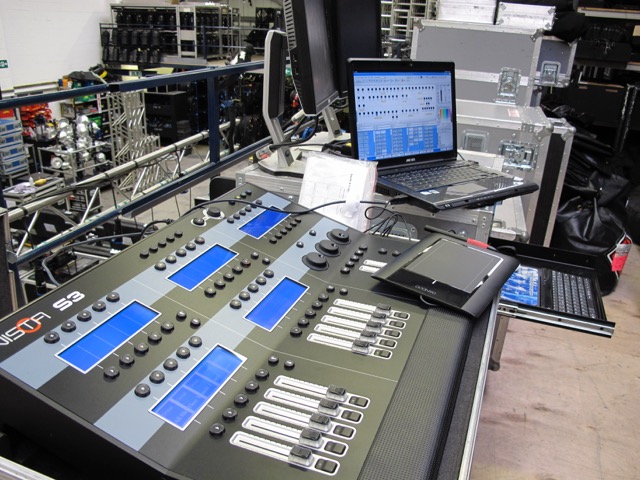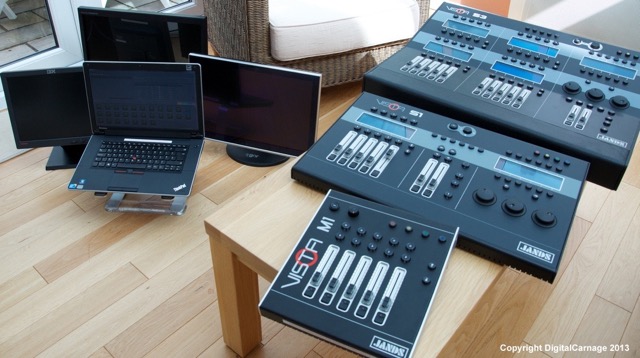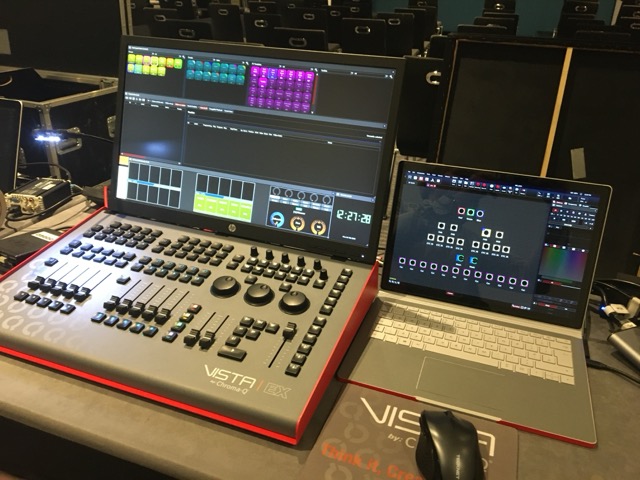Not a bad year in all...
December 19, 2025 Reading time: ~1 minute
Work in 2025 has been pretty good, a busy year really, but, still managed to get some good travel in. Not bad. My thing these days is to get a good work-life balance in. I've had it with chasing work.
Did a nice little tour in Oz and NZ with this bunch of lovely people though, just as the year closed.

This is the Oz crew who were fabulous.... Thanks gang...
However.... Get this lot... This was the fantastic lighting crew from NZ.

Merry Christmas and here's to a fabulous 2026
Del x
What to see at the side of stage
November 7, 2025 Reading time: ~1 minute
Standing stage right, looking across the other side, I was caught by a Perseo on the floor. Nice.
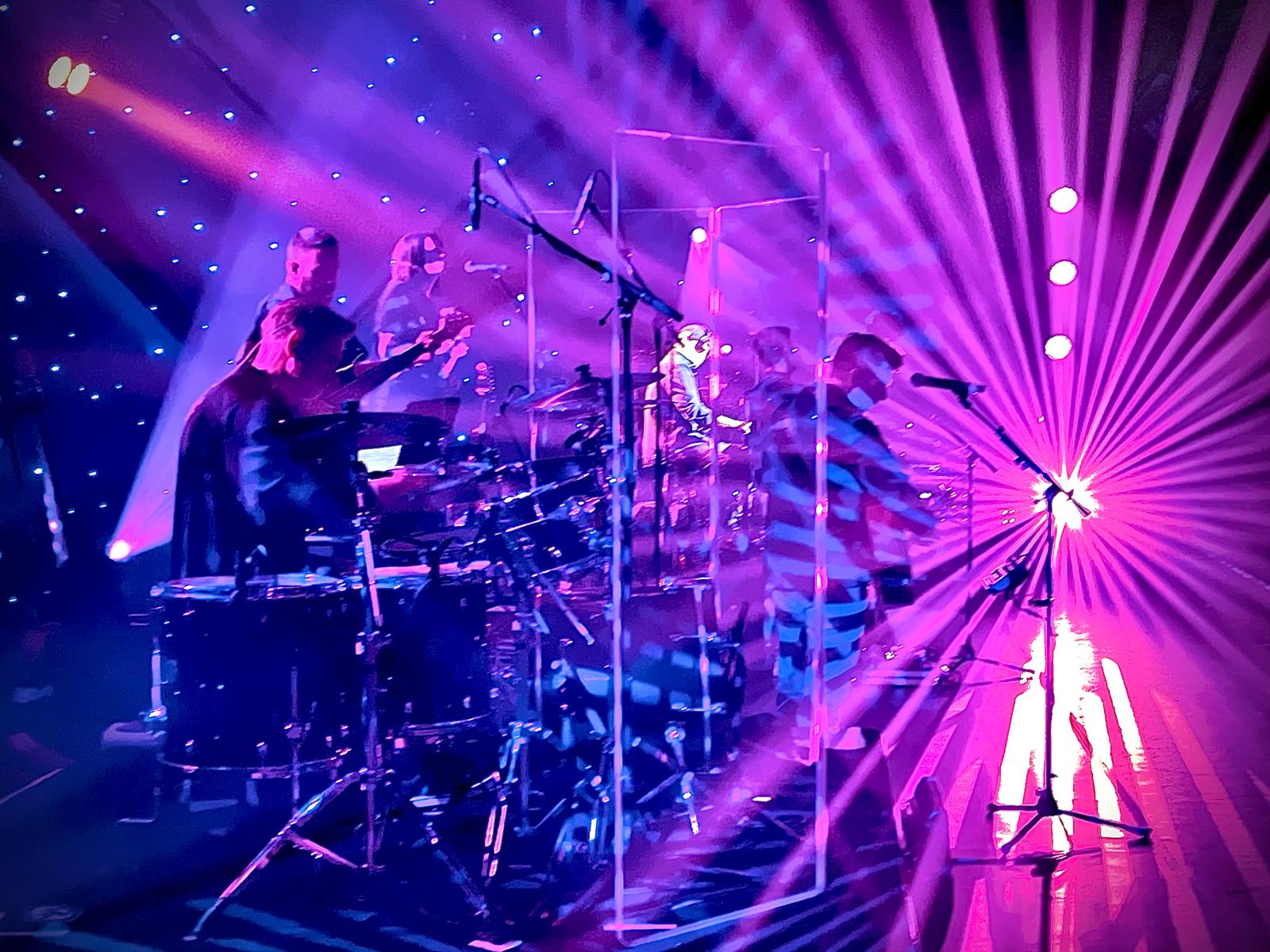
How do you provide redundancy for your Vista?
September 1, 2025 Reading time: 8 minutes
"It's all gone black... Aghhh!"
My current lighting desk is a Vista by ChromaQ. I have two surfaces, the MV and an EX. With all the other bits like a good screen and all the cables, etc, to make it work, it goes into a Peli case that weighs 26kgs, Ideal for flights. Indeed, this set-up has been all over the world on all kinds of gigs and it has never, but I mean, never let me down..!
Despite the reliability of my system, it's always in the back of my mind that I don't have any kind of backup. I have the potential for surface failure or laptop failure, or worse, both! This is no different, of course, from any all-in-one lighting desk; in fact, an all-in-one system is very vulnerable in the event of failure. But let's be honest, the reliability of all these systems, whether it's all in one box or separate computer or surface, is very good today, and no, I don't want to get into a desk-bashing forum here...!
Sure, I can have another laptop on the same network as the spare console and the rig silently tracking, and just move the dongle between the two laptops, but I'm so scared that I will lose the dongle, which the Vista system uses, and to replace my 4098 channel dongle would be too much of a hard, and embarresing pill to swallow. Believe me, I know, I've lost one before, many years ago!!! Doh!
So what options are there for some kind of backup?
Options. What are they?
1. Buy another surface and a second dongle. Obvs!
Lots of expensive kit to cart about. But this might work for you in your case, or in a fixed rig environment.
Pros: The best and most reliable way of having a tracking backup. The "real" way to do it. Cons: Expensive. Needs another Peli case and more space. So now I'm dragging two desks around!
2. Buy just another dongle.
Not as expensive as the first option. Two laptops in the same network, each with a dongle, but those dongles are still pricy!
Pros: Gives a reliable and stable tracking backup. Cons: No surface, so if your show is complicated and requires a lot of button and fader work, then it might be fiddly playing back on a laptop, plus if you have a two-screen layout, you will find that the backup laptop will gather all of the Vista windows into one screen, unless you have a backup screen as well, so will require a bit shuffling about to get to where you want be.
3. Use a KVM switch or just a USB A B switch.
This keeps your system in place, a surface, a screen and two laptops, a main and a backup laptop again in the same network.
Pros: Cheap... Requires just a tiny investment in a USB A B switch. It works! Cons: Don't buy a cheap switch; buy the best you can get. How your system is built may require a bit of replugging. It means that the dongle is out and about. There might be a bit of delay while the hardware detects the licence and completes the handshake with the dongle, etc, and you could hit a Vista "no dongle inserted" thing!
4. Install a lighting cue recorder.
This is a small box that listens to Ethernet/DMX on the network and triggers a cue or sequence when there is no Ethernet from the desk.
Pros: Gets the lights up on stage with no replugging anywhere. Space footprint is small. You can play a single static cue or a full sequence that you grab from your desk. Cheaper than a second dongle. Keeps the dongle in the hardware. Nice and safe, for me anyway! Cons: There is NO tracking, there is no second laptop, so choose your triggered cue or sequence carefully!
Believe me, I have looked and tried all of the above options.
If I'm on a tour, or a biggish gig in my home territory. I'll get production to provide a full backup, surface, dongle, laptop and screen. A full mirrored setup. The issue I have is that any size of show overseas is that not everyone has or can get a Vista system; I'm on my own. Small gigs/lighting providers don't have Ethernet; they are still on copper, yes, they do still exist! My system is just right as it is for what I do, so I need to find a simple, reliable, no-fuss way of getting lights up! As I've said, I don't like having the dongle out of the surface, especially on load-ins and outs, "shit, where's the dongle...?" I never want to have to say that.
Option 1. I really can't afford it! The money, the space and the weight. I'm just a sole trader who does lights and has my own desk. But where I can, I get production to replicate mine
Option 2. The dongle price for existing users, etc, is still too expensive, which I get. Maybe a different licensing system is now required? I use Capture, and the licensing system there is quite nice.
Option 3. I will lose the dongle, whether it's a switch or just hot-swapping the dongle between computers.
Option 4. This is my current chosen way of "...shit! Quick get some lights up..." solution. There are a couple of DMX recorders, but I favoured the Enttec S Play Lite. It is a tiny box, so easy to store and move around. It will store single static cues, which is good enough, but it will also store full sequences. 16 universes of ArtNET or streaming with 2 physical DMX outputs.
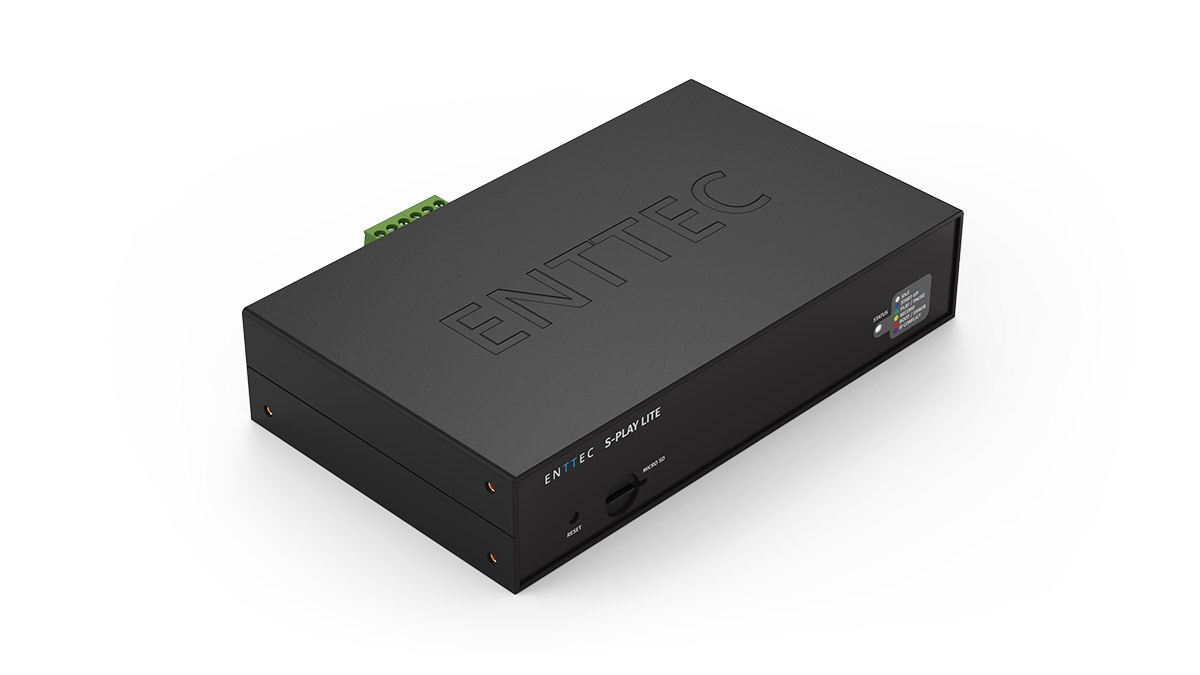
The tiny Enttec S-Play Lite
However... Do we really need a backup nowadays?
If you go to, or do gigs these days, you will not see kit 'backed up'. I've never seen a spare FOH sound desk, monitor desk or VT mixer. Sure, they may have a UPS's etc, but that's to protect against a power outage; but if the amps go off or the lights lose power, all the UPS is doing is keeping the control end active until the amps, etc, come back on, the lights have reset, and the LED screens have powered up. However, I have been to gigs and seen spare lighting desks. Why's that? We have all seen it and done it, 2 GMAs, a pair of Hogs, etc. Curious.
My Journey with Vista, my lighting desk of choice.
August 11, 2025 Reading time: 6 minutes
How did it happen?
Back in 2008, I was looking to own my own lighting desk. I don't know why, I just did, it kinda felt like the right thing to do at the time, I could operate a Whole Hog and an Avolites desk. I was also, before then, quite proficient on the Vari*Lite consoles. Whatever happened to them? Ah, them's were the days. I had just been asked that year to do the set and lights for the Cliff Richard and the Shadows' World Tour, so I thought that would be a good opportunity to buy a desk, but which one?
One wet Wednesday, I was in a well-known lighting hire company's warehouse, and they had a Jands Vista S3 console setup and running it with a MacBook. They allowed me to have a look and to play around with it. I liked it, I liked it quite a lot. There were a few things that I couldn't quite get my head around. The approach to some things was quite a bit different from what I had previously known, so I put the software on my laptop, took it home, and spent a lot of time with it. Soon, I was finding my way around it quite quickly and developing some new muscle memory along the way.
Quite by chance, the S3 came up for sale, complete with an unlimited dongle and the MacBook, so I took a deep breath and bought it. My newly acquired Jands Vista S3 was going on a world tour with an, at the time, large and well known act. Had I done the right thing? Fortunately, it was already flight-cased and ready to go.
My first Jands Vista setup. (with Catalyst)
The tour consisted of a large screen, 20m x 5m of high-resolution LED screen, that was it, really, and a pile of lights. The idea was to push all 5 cameras and content to the screen, make them spin and slide on and off and tumble through a Catalyst media server, which would be fired by my desk along with the lighting, quite a challenge back then. Of course, these days it's easy peasy, but back then, in 2009, it was considered a challenge.
I had help from a wonderful chap, Andy Ryhmes. I'm sure he won't mind a mention here. He was brilliant on the Catalyst side of things and getting the Vista to talk to it. After three weeks in rehearsals, we had a show, a great show that went down a storm. A happy client and happy fans. With my new confidence, I was ready to say goodbye to Andy and face the world on my own.
The tour was a great success, and I continued to do lots of work with my S3, which I soon added to with an S1/M1 combo for smaller gigs. There were plenty of gigs for them all, and my desks were always busy. I loved it!
My Jands Vista Collective...
One day, while touring in Europe, with a band that will remain nameless, I learnt the news that ChromaQ in Canada had acquired the rights to the Jands Vista brand. I was shocked and a bit nervous, but a quick call to the wonderful Jack Moorhouse soon put those fears to rest as he told me the future was good for Vista. he wasn't wrong. I bought the new Vista MV and EX combo, which I have had ever since. This little system has worked very hard for me, with the whole system fitting neatly into a single Peli case, under 32 lbs, just, and has been all around the world doing music tours, corporate events and once of events. Each new release of the software brings something new and useful. I have never ever had a single problem with.
As a side note, I was on a corporate gig in Wembley two years ago, and the console was my old S1/M1 system that I sold. Awww!
I'm not into console wars; they all do the same thing now, especially my Vista by ChromaQ. I'm quite happy to sit on a riser with my small footprint console, providing what my clients want. I have, over the years, fraternised with the GMAPC and the Chamsys desks. I like the small form factor, I like just jamming it all into a Peli and leaving for a hotel or airport, pulling it behind me.
My current Vista by ChromaQ setup
I'm looking forward ot seeing more from Vista by ChromaQ in the future. Bring it on...
DevonThink. An LD's paperless tool...?
August 11, 2025 Reading time: 19 minutes

How I, as a lighting designer, use DevonThink?
Over the years, I have used both PC and MAC computers, but for the last 15 years, I have settled on a MAC for work and personal use. When I bought my first MAC, I came across DevonThink and found the concept very intriguing, but at the same time confusing. I couldn’t quite get my head around it. It all sounded a bit… well… abstract. I had more questions than answers, and I also found it a little clunky, so I gave up. Just like that! I never touched it again. Maybe I was trying to overthink the whole thing. I couldn’t see the wood for the trees, as it was actually very simple.
Fast forward to November 2023, and I thought that I’d give DevonThink another go. I downloaded it and installed the trial, but before the trial had ended, I purchased the Pro version. Now DevonThink is the heart of how I work and run my work life. So how did this happen?
By trade, I am a stage and television lighting designer. I do many different kinds of shows and events, from small 300-people business conferences to arena-sized music shows, TV and video shoots. The biggest thing about my gig is the paperwork. There can be so much of it. CAD drawings, PDFs, images, photos, and all formats of documents such as Word, Pages, and spreadsheets. Sometimes the amount of paperwork for one job can be overwhelming.
My old method of keeping this stuff in order was to create a job folder in Finder with the name of the show, and inside the folder, there would be many sub-folders where I would put all the various assets sorted into categories as they came to me. Later, whenever I needed to access a document, I’d either go into the job folder and click through the sub-folders tree until I found what I needed, or use Spotlight to hunt the document down, which didn’t always work as I would expect. Yes, I used tags, aliases, and so on, and this simple method kind of worked, but it was slow, messy, and clumsy.
DevonThink has changed all of that now and has become the real hub of my work, converting and improving my workflow, making me think and organise myself with more clarity. Now I can find anything that I need with speed, freeing up time to act on what I was searching for and not having to think too hard about where it is in my file structure.
So how do I use DevonThink as a stage and television lighting designer?
It took a little thinking through and a leap of faith. I did a lot of YouTube watching and reading on the DevonThink forum. Lots of experimenting was also done. It’s the best way to learn, just keep a backup, that’s all! I wanted to make sure that I understood clearly what DevonThink was all about. With trepidation, I created a database called WORK. In this work group (or folder for simplicity) I created some more groups that relate to my work. These are just generic work folders that contain health and safety docs, first aid, public liability insurance docs, and other insurance documents. I also have manuals for software and lighting equipment manuals in these folders. I started with items that didn’t change very much, important to my work, yes, but not accessed very often. I did a full Files and Folders Import. DevonThink was to become my go-to place, so Indexing Files and Folders was not for me. I didn’t want to use the OSX Finder at all.
Once I had experimented for a while with these folders and files and was happy, I decided to move over all of my work. The jobs that I am currently working on and the jobs coming up in the future. I kept the original folders in Finder for a while until I was happy and that I wasn’t going to mess it up with DevonThink. The paranoia was so much that I ran both methods at the same time until I was absolutely happy. Even then, I zipped up and archived the Finder items and kept them safe for a while longer… Just in case!
After moving some items around and creating new groups, I wanted to automate the process so that when a new job came in, all the groups that I needed, along with a single “Where are we with this job?” document, would be created and populated for me ready to receive all the documents that would soon come my way.
I started by creating a template that would generate a group of folders for me. I managed to create a template called New Job, which was easy to create within DevonThink and OSX. So now when I click:
Data/New from template/Classifications/New Job
A new group is created in the Global Inbox that looks like this:
To a non-stage lighting person, this probably looks like nothing, but to me, it makes my work much easier and cleaner, and I can change the template as I go, adding and removing folders as my requirements change.
CADS: is where all the CAD drawings go.
Accommodation: Details about where I’ll be staying for the job. This would be a collection of web links, a reservations PDF, etc. I can stay in many different places on a single job!
Travel: Self-explanatory. How am I getting there? What are the details? Flight, train, and car rental dates and times.
Documents: Spreadsheets and text docs, any document that is a non-PDF.
Visuals: This is where all the visuals that I have generated for the client’s show or event using my visualisation software are kept.
Finance: All the quotes from equipment suppliers, my costs, crew costs, etc. Anything to do with money!
PDFs: This folder is always the most populated, as in my industry, the PDF is a big deal!
Notes: Any extra notes that I might take or get about the job that I have to deal with much later on.
Kit Lists: An important one this. It has all the equipment that I will specify and use for the job. This can constantly change.
Images and graphics: Photographs of the venue, and images from the client, such as set ideas, logos, etc.
Inbox: Nothing in here yet.
Anything Else: This is where stuff goes that I can’t put away anywhere else for the moment, or needs me to think about it a bit more.
Capture: This is the virtualisation software I use. Many versions of a show go in here. I can create 3D renders for a client and myself that change regularly, so all the files for Capture go in here.
Finally, JOB NAME - Where are we with this Job? This is a rich text document that does what it says. It’s a partially empty document with some basic information that is already in, such as the show name, client name, and dates of the event. Then, under that, I insert the date and time and then add significant notes and details about the job. Changes to the show, key people’s contact details, change of times, etc., etc.
This document is the hub of the job because anywhere within the document, I can place a copy link from any asset in DevonThink, which will then allow me quick access to the item, saving me from searching for the asset. This doc gets my daily attention as I have to keep it up to date with new and changing information and add any other asset link addresses for later use. I boil down all the important information from all the sub-folders of a job into this one document using links and edit it every day. Being able to link to other items in DevonThink in a document is one of the great advantages of using DevonThink, but you do have to keep it up to date for it to be useful.
This New Job template is created in the Global Inbox. All I do is rename the group with the show name and copy that name to the JOB NAME document within the folder, then move the lot to the JOBS group in my WORK group. Now all my jobs are in one folder.
Then the real fun starts. Items such as drawings, CADs, docs, and PDFs come via email, shared, or AirDropped to me. In the old days, I’d just gather this new stuff on my desktop and then file it into the appropriate folders in Finder. Now DevonThink AI does this for me.
I was a little sceptical about this function at first, but I found that the more data I put into DevonThink, the more the AI kicked in and suggested the right folder to put items into. Now, 90% of the time, DevonThink knows which job group and sub-group an item needs to go to. It is rather spooky to watch, but I can tell you it does work.
Each job can have lots of emails and documents. For each attachment or shared item that comes to me, I just put it into the Global Inbox via OCR, and I convert almost everything I can into a searchable PDF. Everything goes in there, but I mean everything. I print nothing, I save nothing in the usual way in Finder. I just send it to DevonThink. It’s like a “scruffy” unorganised folder where stuff just gets thrown into for sorting later. I didn’t intend to go paperless; it just happened naturally. I have invested in a scanner now, so if I do get given something on paper, I scan it into DevonThink and I’m done.
So I have all these items in my Global Inbox. When do I clean it up?
This usually happens at the end of the working day. I get a large glass of red wine and I go through all the items in the Global InBox. As I click each item in the Inbox, the See Also & Classify tab in the inspector suggests where the item should go in my database. First, I read or look at an item and act on it if I need to, copy the link item into my “Where are we with this?” document. I’m a big fan of tags, so I will tag the item, then click the suggested location in See Also & Classify, and boom, it’s gone to the right group.
When I go to a meeting or an on-site location, I use my iPhone or iPad to recall everything I need to know about the job I’m working on. All at my fingertips and instantly available. No trawling through folders or searching with Spotlight. Using DevonThink To Go, all my jobs and the assets for the jobs are all there. Using an Apple Pencil, I can amend PDFs and schedules, etc. During the meeting, all my new notes get synced back to my MAC for sorting later on. The DevonThink sync function is taken care of using WebDAV to my self-hosted Nextcloud instance. It has not let me down yet!
It has taken a bit of trial and error. Reading, watching, and listening to other DevonThink users, but without a doubt, my old cumbersome, messy workflow is now streamlined and easy. I am spending less time looking for stuff, now I’m doing stuff. My creative lighting designs may not have improved, but the way I put a job together and manage it is now at another level.
Now I can’t do without my DevonThink. I am now in the process of moving and administering all my personal stuff. I have created a new database called Personal, and everything not work-related is thrown into it. I write as a hobby, so I have moved my research and writing to DevonThink.
Of course, people have different jobs and have different ways of using DevonThink. My method is no big deal, but I wanted to share how I use this software. Maybe you have spotted another way of doing what I do, or maybe I have given you an idea of how to streamline your work.
Help or harm?
Dj
Have a look at the DevonThink website for more details.
